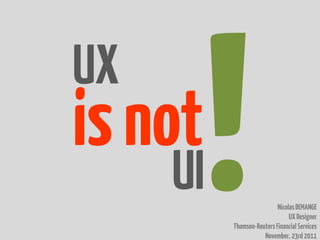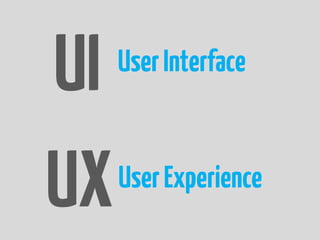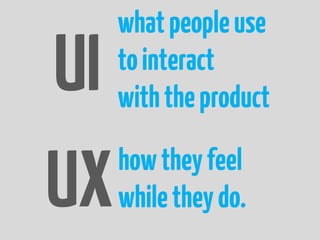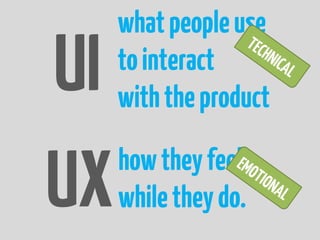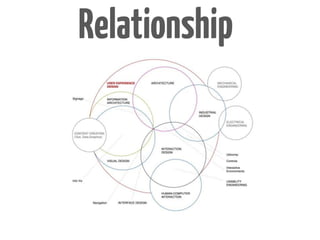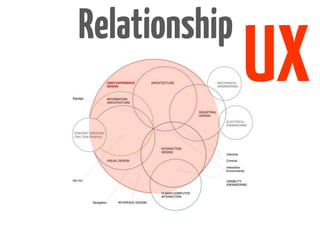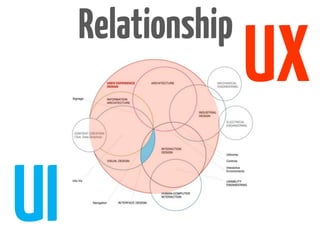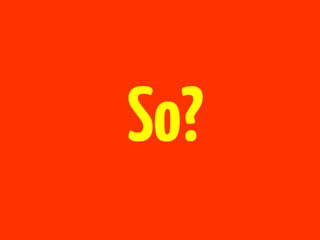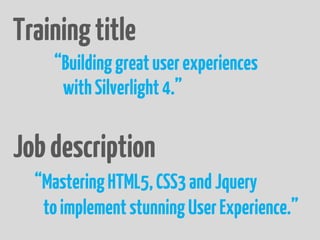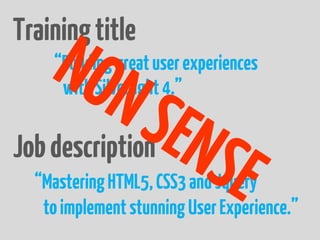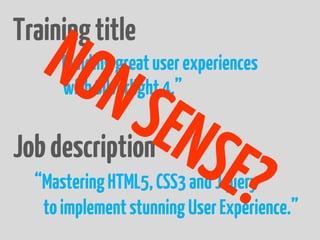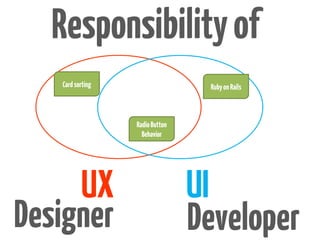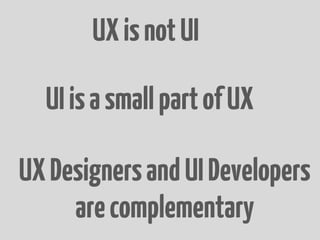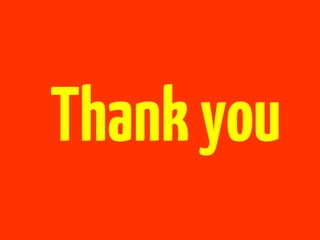UX is not UI!
- 1. UX is not UI Nicolas DEMANGE UX Designer Thomson-Reuters Financial Services November, 23rd 2011
- 3. So…
- 4. UI User Interface UX User Experience
- 5. what people use UI to interact with the product UX how they feel while they do.
- 6. what people use UI to interact with the product UX how they feel while they do.
- 7. Relationship
- 8. Relationship UX
- 9. Relationship UX UI
- 10. So?
- 11. Training title “Building great user experiences with Silverlight 4.” Job description “Mastering HTML5, CSS3 and Jquery to implement stunning User Experience.”
- 12. Training title “Building great user experiences with Silverlight 4.” Job description “Mastering HTML5, CSS3 and Jquery to implement stunning User Experience.”
- 13. Training title “Building great user experiences with Silverlight 4.” Job description “Mastering HTML5, CSS3 and Jquery to implement stunning User Experience.”
- 14. Responsibility of Card sorting Ruby on Rails Radio Button Behavior UX UI Designer Developer
- 15. To sum up
- 16. UX is not UI UI is a small part of UX UX Designers and UI Developers are complementary
- 17. Thank you
Editor's Notes
- #3: X canbeseen as a crossed I. That REALLY means UI is NOT UX. The lettersthemselves are talking to you!
- #4: So… Let’sget more in details but not thatmuch. This presentationonlypurposeis to makeyoufinally stop confusing/mix up the two concepts. It won’texplainyouwhat UX is or what UI is. Just show youthatthey are not the same.
- #5: UI stands for User Interface.UX stands for User Experience.Interface on the first hand, Experience on the second hand. Twodifferentwords. So whymixingthem up! They are different.
- #6: The User Interface iswhat people use to interactwithproductwhere as the User Experienceis how theyfeelwhilethey do.If yourememberthisthenthiswholepresentationis a success and becomesuseless.
- #7: So anytimesomeoneistalking about technology, componentimplementation, platform etc. justscreamathim if heintroduces « UX » in the same sentence.UI istechnicalwhereas UX isemotional.From the beginning of thispresentation, I’mspeaking as if all of thisisobvious and thatyou are dumb.Of course… not! There is the reasonwhy people confuse thosetwoterms.
- #8: People tend to mix UI and UX up because on the first hand theysimply do not know what lies under the User Experienceterm and the other hand becausethereis an actualrelationshipbetween the two of them.
- #9: Hereis a simple (YES itissimplified) schema of the User Experience Design. There is lots of things. Of complexthings. Of thingsthat have relationshipsbetweenthem.Amongstthemyou have…
- #10: … User Interface Design. Yes, here in the blue part. In the UX world, UI canbeseen as the intersection of visual and interaction design. (Simplified I said!)And as the User Interface is the most tangible thing in here, itis the main thing people refer to whentalking about.So here, youjustneed to remember, one more thing: UI is a small part of UX.
- #11: Nowthatyou knowthat UI is not UX and vice versa, whenyouwillseethiskind of things…
- #12: .. You notice directly the presence of UX and silverlight (microsoft UI techno) in the same sentence… and scream.Same for a job description… You scream!
- #13: Is itobviousnow?
- #14: Wellit’s not thatobvious. Thereisstill a thing to clarify.
- #15: UX and UI do not exclude each other. They are complementary. You need both a UX designer AND a UI Developer to build a good product.So when comes the question of responsibility, sometimes they are both responsible.You may find a UI Developers that knows user-centric concepts and lots of UX aspect.But those are two full-time complex jobs. So, last lesson: UX Designers and UI Developers are complementary.----------------UX Designer—One who designs the user experience for applications after doing user and workflow analysis, producing user-centered design artifacts such as personas, site maps, taxonomies, and wireframes. A UX Designer may also conduct usability testing on prototypes or finished products to assess the quality of a user experience.UI Developer—One who builds user interfaces that support the exchange of information between an application’s users and its back-end processes and databases. This could be either a fully dedicated role on a development team or a hat a developer who is also responsible for coding the back-end processes might wear. A UI Developer’s output is functional, testable, shippable code that lets users accomplish their goals when using an application. The UI Developer is also responsible for documentation that allows others to maintain their code.
- #16: To sum up!
